
Visit Our Thirteen Individual Garden Areas
1. HOA Friendly Entry Garden
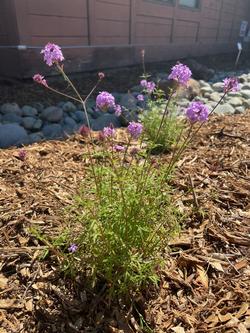
Verbena lilacina 'De La Mina'
The HOA (Home Owners’ Association) friendly beds are planted with cultivars and straight species of California native plants. These are plants that thrive in our Mediterranean climate and support local biodiversity.
To be included in the garden plants need to meet certain requirements:
- Readily available to the home gardener
- Attractive year-round
- Have low to very low water requirements
- Mostly evergreen
As in residential yards, utility equipment is an unfortunate focal point. Therefore, every effort has been made to choose plants that will screen or hide these obstacles.
- Straight species of deer grass, toyon, and western redbud
- Concha was selected to screen the HVAC system
Since Loomis Library doesn’t have gutters to steer runoff, rain garden plants of Carex and Juncus have been planted along the front of the building. These plants also do well in summer when there is no rainfall.
Groundcovers in the entry garden include California fuchsia, coyote brush, manzanita, and yarrow.
2. Orchard
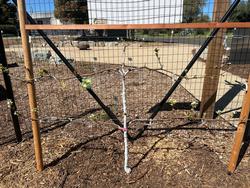
Espaliered Apple Tree
Seven fruit trees are part of our demo garden, including pome (apples and Asian pear), stone (plum, cherry and pluot) and citrus (Satsuma mandarin orange and Meyer lemon). There is also a strawberry guava and four blueberry bushes.
- All fruit trees should be under 7 feet tall in order to be maintained without ladders.
- Asian pear is espaliered.
- Apple trees are espaliered, one is a “6 in 1” multi-graft.
- Compact Stella cherry and Meyer lemon are grown in large pots, illustrating that small spaces can have fruit trees.
- Satsuma mandarin orange is grown in a raised bed with other edibles.
The fruit flowers provide pollen and nectar for the bees and butterflies during the spring season. No chemical pest or disease controls are utilized.
Trunks are painted white to prevent sunburn which causes cracks that allow further/deeper burning and access for critters to burrow in. The paint is a 50/50 mixture of interior latex paint and water.
The areas around most fruit trees have a thick mulch for soil health and weed control.
3. California Native Woodland
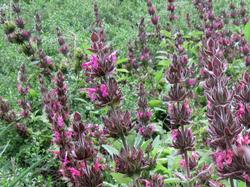
Hummingbird Sage
Foothill woodlands habitat is the natural habitat for much of this part of Placer County. Native plants, well adapted to our region, support local birds and butterflies plus give our gardens a “sense of place.”
Common trees include blue oak, Interior live oak, and valley oak.
Understory plants include buckbrush, coffeeberry, manzanita, and redbud.
Wildflowers include brodiaea, iris, larkspur, lupine, mariposa lily, miner’s lettuce, shooting star, and yarrow.
Specific plants to look for throughout our Demo Garden:
- Blue elderberry: Multi-branched shrub with creamy-white flowers in the spring and purple berries in the summer. A favorite of birds and pollinators plus sole host for threatened valley elderberry longhorn beetle.
- Deergrass: Large ornamental grass is low maintenance with low water use.
- Hummingbird sage: Grows well in shade/part shade under trees and large shrubs. It is drought tolerant and can survive without summer irrigation once established; some supplemental water will keep the foliage green.
- Redbud: Showy shrub with magenta-pink flowers in the spring, round lily-pad shaped leaves in summer, and yellow fall foliage; low maintenance and low water use.
- Seasonal pairing: Purple blooms of coyote mint and yellow flowers of sulphur buckwheat occur together naturally in the Sierra Foothills which are a striking color combination and irresistible pollinator magnet.
4. Pollinator Island #1
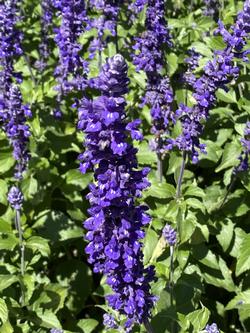
Salvia Indigo Spires
This bed features plants that are attractive to bees, butterflies, and hummingbirds. All of these flying creatures are considered to be pollinators, meaning they transfer pollen from one flower to another as they either sip nectar or actively or inadvertently pick up pollen as they go.
- Common yarrow has clusters of disc-shaped flowers (called umbels) which provide nectar and pollen for bees, butterflies, and ladybugs. In fact, ladybugs use this native yarrow frequently as a “nursery,” where they lay their eggs and then the larvae hatch out. These are great plants to intersperse in your flower beds AND veggie gardens, as the ladybug larvae are voracious eaters of aphids.
There are two varieties of pincushion in this bed, both attracting butterflies and bees to this garden.
- Black pincushion
- Florists pink pin cushion
Do you see a shallow terra cotta saucer in this bed?
This is called a “puddling station” and is filled with a damp mixture of sand, compost, and a few larger stones. Butterflies will use this station to gather moisture and to extract minerals needed for reproduction. The larger stones are for perching. In the wild, you can observe butterflies sipping near a sandy moist pond or river edges.
5. Pollinator Island #2
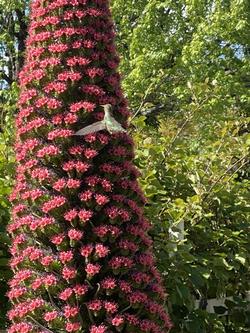
Tower of Jewels
This bed features plants that are attractive to bees, butterflies and hummingbirds. All of these flying creatures are considered to be pollinators, meaning they transfer pollen from one flower to another as they either sip nectar or actively or inadvertently pick up pollen as they go.
- Chick lupine is a favorite pollinator plant for many species of native bees, including Mason bees, gentle solitary bees which are excellent early season pollinators during fruit tree bloom time. This annual plant is also a possible larval host for many species of butterflies and moths
- Purple needlegrass has been our state grass since 2004. Its deep roots make it good for erosion control. Birds will eat the seeds and a few butterflies use the plant as a larval host plant. (The female butterfly will lay eggs on them, and the resulting caterpillars eat the plant as “baby food.”)
- Tower of jewels is a biennial plant that blooms in its second year. (The first year it grows a large rosette of silver leaves.) It is a super plant for hummingbirds and bees. The plant can reach up to 8’ high, is deer resistant and is drought tolerant. It has blue pollen! Be sure to check the bees that visit for this pollen.
6. Pollinator Island #3
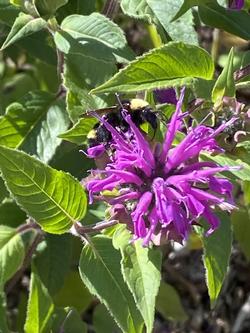
Blue Stocking Bee Balm
This bed features plants that are attractive to bees, butterflies and hummingbirds. All of these flying creatures are considered to be pollinators, meaning they transfer pollen from one flower to another as they either sip nectar or actively or inadvertently pick up pollen as they go.
In this bed are several species of native milkweeds that are the larval host plants that are used exclusively by Monarch butterflies for laying their eggs. This bed features two of Placer County’s milkweed species:
- Narrowleaf milkweed
- Showy milkweed
These plants go dormant in late fall (completely dying to the ground) and return again in spring. Their flowers are very attractive to bees.
- Bee balm is a terrific pollinator plant, especially attractive to bumble bees. You may notice quite a crowd nectaring at the same time.
- Coyote mint is an excellent plant choice of a native groundcover for nectaring butterflies.
7. Pollinator Island #4

Desert Globemallow
This bed features plants that are attractive to bees, butterflies and hummingbirds. All of these flying creatures are considered to be pollinators, meaning they transfer pollen from one flower to another as they either sip nectar or actively or inadvertently pick up pollen as they go.
- Desert globemallow is attractive to bees and butterflies for its pollen and nectar, as well as being a larval host plant for butterflies and moths. Many cavity nesting bees seek out its hollow or pithy stems in which to lay their eggs and where their larvae can form.
Support native bees by growing pithy-stemmed plants like desert globemallow and by leaving 8-12” cut lengths of attached spent stems to allow bees to use them!
This bed features the third Placer County Native milkweed, woollypod milkweed, an important larval host plant for Monarch butterflies.
Hummingbirds and butterflies love hummingbird mint, tall verbena, and wild bergamot.
Bees of all kinds are especially attracted to rock purslane, which is a succulent.
8. Rain Garden
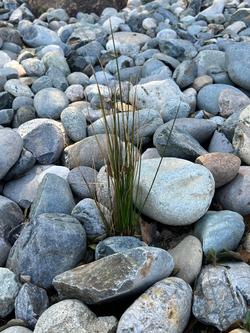
Soft Rush
A rain garden collects rainwater, holds it for a limited amount of time, and filters it before slowly releasing the water into the ground. It collects rainwater from surfaces such as roofs, pavements, driveways, patios, parking lots, or waterlogged yards, allowing the water to slowly seep back into the ground, preventing runoff from reaching local waterways. A rain garden is not a water garden since rain gardens are mostly dry and drain within 12-48 hours.
Benefits:
- Protects the environment by reducing runoff pollution.
- Reduces runoff by being placed in a location enabling the garden to collect water.
- Provide food and shelter for wildlife and pollinators, such as butterflies.
- Controls soil erosion.
- Reduces mosquito breeding problems when standing water is eliminated/reduced.
How to Design a Rain Garden
- Determine if soil is suitable - Does not have heavy clay soils
- Location - Fed by one or two downspouts, 10 feet from buildings, not over utilities, near a septic tank or well.
- Depth - Typically 4 to 8 inches and not to exceed 8 inches.
- Shape - Crescent, oval, teardrop or kidney are more appealing than a rectangle.
- Plant Selection - Native plants that tolerate variable moisture.
- Enhancements - Rock, stonework, fences or other ornaments.
9. Hedgerow
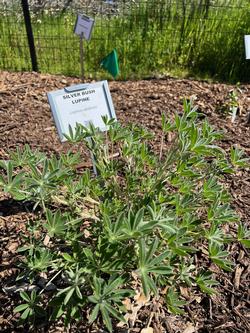
Silver Bush Lupine
Hedgerows are dense vegetation (perennial grasses, shrubs, and trees) planted along the edges of fields.
An ancient feature of agricultural landscapes throughout the world, hedgerows are increasingly recognized for their significant ecological benefits. These benefits include:
- Increases biodiversity with habitat for wildlife including birds, insects and mammals.
- Serves as field boundaries and creates natural windbreaks.
- Improves ecosystem function and resiliency.
- Protects and improves both water runoff and groundwater quality.
- Provides supplemental food such as fruits, nuts, and herbs.
- Supports natural enemies of common crop pests and crop pollinators.
Hedgerows planted primarily with California natives support higher populations of common and rare birds.
Our hedgerows use plants found in the Sierra Foothills: Coffeeberry, redbud, and sentinel manzanita.
10. Edible Garden Beds
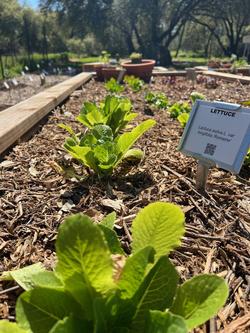
Romaine Lettuce in Raised Bed
These beds have seasonal (Cool and Warm Season) vegetables and berries planted in the ground plus in five raised beds (including one accessible bed).
- Culinary herbs and edible flowers are planted in raised beds, terra cotta pots (demonstrating container planting for smaller home/apartment growing possibilities) and in orchard area ground cover.
- 4’ x 4’ Beds demonstrating Hügelkultur (German word meaning ‘mound culture’), growing plants in decomposing organic materials providing natural long-term fertilizer as well as reducing water and irrigation need.
- In ground bed planting of Native American style of the ‘Three Sisters’ (corn, beans and squash) which provide each other support, soil nitrogen and water retention while growing.
- All edible plant flowers provide pollen and nectar for the bees and butterflies/moths.
- No use of chemical pest controls. Plants purchased from nurseries that do not use herbicides or pesticides.
11. Straw Bale Gardening
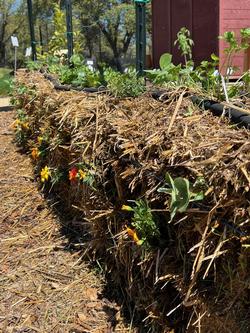
Straw Bales
This illustrates how to create a beautiful garden with straw bales.
Benefits
- Cheapest raised bed
- No soil or weeding required
- Less water consumption
- Extends the growing season
- Plenty of room to plant- top, sides, and end of bales
- Creates super compost at end of growing season
How to construct a Straw Bale Garden
- To deter Gophers place hardware cloth on the bottom of the bale.
- Place string bale cords on the side and ensure no herbicide has been used.
- Pretreat 2 weeks before with high nitrogen fertilizer. Bacterial composition turns into a warm, fertile planting ground.
- End of 2 weeks apply balanced fertilizer (10-10-10).
- Use a trowel to dig holes in the bale.
- Add a handful of sterile plant mix, seeds/plants and a dose of water.
12. Lawn Alternative Meadow
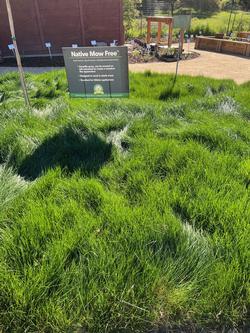
Native Mow FreeTM Grass
Native Mow FreeTM grass from Delta Bluegrass is versatile and adaptable to different mow heights. This slow growing, shade tolerant, fine-textured grass can be mowed at 4-6 inches or left unmowed as a beautiful garden meadow.
Because native grasses are adapted to survive in almost any soil condition, they require little to no inputs such as fertilizer or pesticides plus use significantly less water. Landscaping with native grasses can be a wise environmental decision, especially when combined with California native trees, shrubs, and wildflowers. Benefits to homeowners and our environment including providing food and shelter to beneficial insects, butterflies, ladybugs, and wildlife.
Shade Tree
With limited space to feature one shade tree, we chose the Chinese pistache. This drought and heat-tolerant tree, reaching 25-35’ tall, has a wide spreading canopy with a deep vivid red fall color. A great deal of pruning is not required to keep the tree strong and attractive. As this tree can be somewhat invasive in wetlands, we planted the easily found male cultivar called 'Keith Davey.'
(A close second was the chitalpa tree, a cross between our native desert willow and non-native catalpa. It is a deciduous small tree with attractive orchid-like flowers. This tree does well in low to moderate water and full sun.)
13. Compost Area
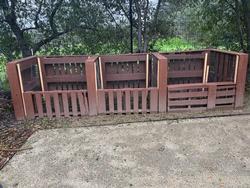
Compost Bins
Benefits of Composting
- Easy, low cost, and a compost pile can fit any yard
- Aids the environment and improves soil structure by increasing water holding capacity, supplies
nutrients to plants, feeds micro-organisms, and reduces the need for expensive chemical fertilizers
Different types of composting bins: 3 Bin System; Geobin; RUEC (Roseville Utility Exploration Center) Garbage Can; Tumbler
Particular system depends on
- Labor and Cost - How much time and money can you invest?
- Rate of Results - Faster results require close supervision.
- Organic Material Availability - This makes a big difference!
What layers go into the pile?
- Nitrogen or “greens” - vegetable or fruit scraps, grass clippings, coffee grounds, manures and alfalfa hay
- Carbon or “browns” - dry leaves, straw, sawdust, wood chips, corn stalks, and cardboard/paper
What does not go into the pile?
- Diseased/infected plants or weeds or plants with severe insect attack
- Cat/dog manures, meat, dairy, or fish
- BBQ or wood ashes




